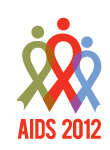 Compared with Norvir (ritonavir), people living with HIV using Gilead Sciences’ novel boosting agent cobicistat were just as likely to see their viral loads drop to undetectable levels and no more likely to discontinue therapy due to side effects, according to preliminary results from a Phase III study comparing both drugs in combination with Reyataz (atazanavir) and Truvada (tenofovir plus emtricitabine). The study’s 48-week findings were reported Tuesday, July 24, by Joel Gallant, MD, of Johns Hopkins University and his colleagues at the XIX International AIDS Conference in Washington, DC.
Compared with Norvir (ritonavir), people living with HIV using Gilead Sciences’ novel boosting agent cobicistat were just as likely to see their viral loads drop to undetectable levels and no more likely to discontinue therapy due to side effects, according to preliminary results from a Phase III study comparing both drugs in combination with Reyataz (atazanavir) and Truvada (tenofovir plus emtricitabine). The study’s 48-week findings were reported Tuesday, July 24, by Joel Gallant, MD, of Johns Hopkins University and his colleagues at the XIX International AIDS Conference in Washington, DC.
Cobicistat is an experimental pharmacokinetic enhancer—a drug used to boost other medications, notably protease inhibitors, in the blood to make them more effective—now being reviewed by the U.S. Food and Drug Administration. It is a component of Gilead’s experimental fixed-dose combination tablet known as the “Quad,” which is expected to be approved soon, and is also likely to be approved as a stand-alone agent for use in combination with antiretrovirals (ARVs) that currently require boosting using low doses of Abbott’s protease inhibitor Norvir.
Cobicistat’s potential as a Norvir alternative is important. For one, while it has a pronounced effect on the enzyme system (CYP3A) responsible for breaking down several HIV drugs, it doesn’t affect other enzyme systems used by many other medications—a common problem with Norvir that contributes to numerous potentially harmful drug interactions.
Study 114, a Phase III clinical trial, is being conducted by Gilead to explore the effectiveness and safety of cobicistat-boosted Reyataz versus Norvir-boosted Reyataz over a 96-week period at more than 200 study sites internationally. The researchers allotted nearly 700 HIV-positive individuals starting antiretroviral therapy for the first time to receive 150 milligrams (mg) cobicistat or 100 mg Norvir, both in combination with Reyataz and Truvada (tenofovir plus emtricitabine).
On average, volunteers were 36 years of age upon entering the study; 83 percent were male and roughly 60 percent were white. The average viral load at baseline was 65,000 copies, with roughly 39 percent entering the trial with viral loads in excess of 100,000 copies. Approximately 17 percent had a CD4 count below 200 cells.
Similar rates of virologic suppression—defined as a viral load below 50 copies—were maintained through the follow-up period. After 48 weeks of treatment, 85 percent in the cobicistat group and 87 percent in the Norvir group had viral loads below 50 copies. Given the similar response rates in the two groups, cobicistat was considered to be “non-inferior” to Norvir.
Approximately 6 percent of patients in the cobicistat group experienced virologic failure during the study, compared with 4 percent of those in the Norvir group. As for the development of drug resistance, two study volunteers in the cobicistat group developed nucleoside reverse transcriptase inhibitor-associated HIV mutations. No patients who experienced virologic failure in the Norvir group had evidence of drug-resistance mutations.
CD4 counts increased, on average, by 213 cells in the cobicistat group and 219 cells in the Norvir group; this difference was not statistically significant.
As for adverse outcomes, Gallant noted similar side effect-related discontinuation rates in both groups. Approximately 7 percent of patients in both treatment groups discontinued therapy because of adverse events.
The most common laboratory abnormalities—occurring in more than 5 percent of patients in the study—were elevated bilirubin level (a common side effect associated with Reyataz documented in more than half of patients in both groups) and elevated creatine kinase levels, a sign of muscle breakdown.
Increases in creatinine levels—a potential sign of kidney toxicity—were more pronounced in the cobicistat group (a 0.13 milligram per deciliter [mg/dL] increase) compared with the Norvir group (a 0.09 mg/dL increase). Gallant noted, however, that discontinuation of treatment due to kidney concerns was infrequent in both groups (1.7 percent versus 1.4 percent, respectively).
Small increases in total cholesterol, “bad” LDL cholesterol, “good” HDL cholesterol and triglycerides were documented in both groups, with no statistically significant differences between those taking cobicistat or Norvir.
The most common clinical adverse events, occurring more or less equally in both groups, were yellowing of the skin and eyes (jaundice, which was likely related to the use of Reyataz), yellowing of the eyes (ocular icteris), nausea, diarrhea, headache and upper respiratory tract infections.
Cobicistat-boosted Reyataz was non-inferior to Norvir-boosted Reyataz in combination with Truvada at week 48, Gallant concluded. “Both regimens achieved high rates of virologic success. Safety and tolerability profiles of the two regimens were comparable."
Advertisement
Advertisement
Advertisement






Comments
Comments